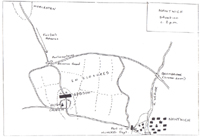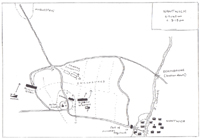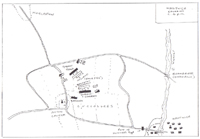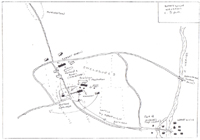If Fairfax's plan was to succeed, speed was essential, but once again there was delay. It was necessary to deploy the troops into column again, led by pioneers with axes to cut gaps where necessary in the hedgerows. They were supported as a "forlorn hope" by Captain John Hodgeson's West Riding musketeers. There was limited room for manoeuvre between the right flank of the Royalist position around Acton Church and the flooded water meadows of the Weaver, but, as Fairfax reported: "We resolved to make our way with pioneers through the hedges, and so to march to the town to relieve it, and by it, to add some forces to ourselves, to enable us better to fight with them." [14]

No surviving account states at exactly which point Fairfax branched off the Chester-Nantwich road and headed off across country. He would presumably have wanted to make as short a detour as possible. and we know that his advance forces were already within cannon-shot of the Royalist position at Acton Church. It seems most likely that the Parliamentarian column struck off across the fields in an easterly direction at the modern junction between the A51 and A534 at Burford, intending then to swing south-east and hit the land known as Welshman's Lane around Welshman's Green, and thereabouts to link up with the Nantwich troops.
Large Map 1: Situation circa 2pm
Jumbo Map 1: Situation circa 2pm (slow: 68K)
Royalist sources are silent as to how much disarray Fairfax's move may have thrown them into. Lord Byron, without explicitly saying as much, gives impression that he did not arrive on the scene until after Gibson had already deployed the bulk of the Royalist troops. Gibson. he said, "was confident that we had advantage enough over them....The place of battle was in an enclosed field, where horse could do little service, and not above a mile from Nantwich; which I fore-warned the Major-General of, and desired special care might be taken lest we should receive prejudice by any sally out of the town, which he assured me he had done. His own regiment had the right wing; my brother's the left; Warren's and Sir Michael Ernley's the battle; Huncke's regiment was to wait upon them that should attempt to sally out of the town." [15]

Now Byron's version is misleading in a number of respects. He is anxious to shift responsibility as much as possible onto Gibson (who, conveniently being a prisoner at the time, was unable to state his own case) and he also gives the impression that the Royalist army was much more formally deployed than was the case in reality Robert Byron is somewhat more forthcoming: "our army was drawn in several enclosures, there our horse (which we were superior in) could do no good, nor we help one another, by reason of the great distance from one another." [16] The Royalist army was, in fact, (as Map 2 shows) divided into two distinct parts.
Large Map 2: Situation circa 3.15pm
Jumbo Map 2: Situation circa 3.15pm (75K)
Not surprisingly, neither Royalist commander was willing to admit that, despite the still disorganised state of their formation, their forces took the offensive. In fact, of course, Byron had little option if was to avoid either abandoning operations against Nantwich or fighting much less favourable next day. It has been suggested that what now occurred may have been a spoiling attack which got out of hand, [17] but there is no reason to believe that the Royalists intended anything less than a general attack, which in the event was delivered in a somewhat piecemeal fashion.
By about 3 p.m., Fairfax's men had just begun their detour across the fields, moving slowly because of the need to keep formation and to clear a path through the hedges. Details of their order of march are sketchy, but it seems that their baggage and whatever guns they possessed were in the the van, along with Lambert's horse and Brereton's and Assheton's foot, together with Hodgeson and the 'forlorn hope". The foot units commanded by Richard Holland and John Booth were certainly in the rear, probably with Sir William Fairfax's horse, and Sir Thomas's own Regiment, commanded by Major Rousby. What is clear is that Fairfax's timetable was falling seriously behind, and he now received reports of a Royalist force approaching to fall on his rear.
The attackers consisted of Robert Byron's foot. They had been part of the force which had been on the east bank of the Weaver, and which, coming up on the left of Gibson's force at Acton, had wheeled right to strike against the rear of the Parliamentarian column. At the same time, Gibson, with Warren (and perhaps Earnley, though his unit may have remained nearer to Acton Church), and possibly supported by some of Huncke's men, extended to their right and advanced towards the head and flank of Fairfax's column.
Writers have expended a good deal of effort in attempts to fit what we know of the battle into the pattern of a conventional action between two armies drawn up facing each other in orthodox formation, or to have Fairfax somehow switching from column to line and facing right to meet a general attack on his flank. This is extremely difficult to account for satisfactorily, mainly because it probably never happened. What rather occurred were two separate engagements about A a mile apart between (roughly) the two halves of each army, as it is hoped that the following description will clarify.
Seeing Robert Byron's men approaching his rear, Fairfax faced about Holland and Booth's men. and supporting them with his regiment of horse, led them back to engage the attackers. Fairfax left two very brief descriptions of what was now happening, which, read together, make the onset of the battle reasonably clear, and also emphasise how the nature of the terrain limited observation of what was happening. In he despatch of January 29th to the Earl of Essex, Fairfax wrote: "But being a little advanced in our march, they [presumably meaning messengers from the rear] told me the enemy was close upon the rear. So facing about two regiments, being Colonel Holland's and Colonel Booth's, I marched not far before I came to be engaged with the greatest part of their army. The other part presently assaulted our front." [18] In his "Short Memorials", written many years later, Fairfax is slightly more explicit: "But after we had gone a little way, word came that the Enemy were in the Rear. So facing about two Regiments and my own Regiment of Horse, commanded by Major Rousby, we relieving those that were already engaged. And so the fight began on all sides. These that fell on our Rear were those that lay on the other side of the town; which had passed the river. Those that were drawn up under their Works fell on our Van, which was marching to the Town. Thus was the battle divided; there being aquarter of amile betwixt us." [19]

It is important to note that Gibson's men, possibly because they had to re-align themselves first, and possibly because Warren's men may have lacked commitment, attached somewhat later than Robert Byron. This was fortunate for Fairfax, for the two parts of his army now found themselves deployed, (though a mile apart) back to back, and coming under severe pressure (See Map 3).
Large Map 3: Situation circa 4pm
Jumbo Map 3: Situation circa 4pm (101K)
Battle was joined just before 3-30 p.m., and seems to have continued for about two hours. The initial Royalist assaults seem to have met with some success. Captain Hodgeson, with the Parliamentarian van, admitted that "much ado we had to deploy into line to meet the advancing Royalists. The Parliamentarians must still have been somewhat disordered when Gibson made contact. Fairfax said of the encounter between the Parliamentarian van and Gibson's wing of the Royalist army: "They were once in great danger", [20] whilst Byron claimed that Gibson's attack "had much the better of them", forcing the Parliamentarians back and taking a number of guns. [21]
In his attack on Fairfax's rear, Robert Byron also seems to have met with initial success, though Robert was rather more moderate in his claims than his brother, saying that "Gibson's regiment and mine held them in very good play and lost nothing by them." [22] Fairfax however suggests that his men were initially in serious trouble: "We in the other wing, were in as great distress, but that the horse, commanded by Sir William Fairfax, did expose themselves to great danger to encourage the foot, though capable of little service in these narrow lanes." [23] In his "Short Memorials" Sir Thomas gives a little more detail: "In the division first engaged, our foot at the beginning, gave some ground, but our Horse recovered this, by beating the Enemy's horse out of the lanes that flanked our Foot." [24]
The whereabouts and actions of the Royalist horse during the battle are obscure. Lord Byron is dismissive of their role. "The ground was so enclosed the horse could do no service, and some of them, who were struck with a panic fear, so disordered the rest, that though they did not run away, yet it was impossible to make them charge." [25] Ignoring the fact that if the ground was as unsuitable as Byron claimed, it is hard to see how the horse could have charged anyway, it certainly seems that the Royalist horse played a fairly minor role in events.
The "lanes" referred to by Fairfax seem likely to have been the Chester-Nantwich road itself, and the one (A534) leading off it to Beambridge. It seems that the Royalist horse launched some halfhearted probes along these in support of Robert Byron, whose men were fighting in the angle between the two roads, but the Royalist cavalry were quickly driven off, with few losses, by Sir William Fairfax's horse.
In the action between Gibson and the Parliamentarian van division, the foot commanded by Sir William Brereton and Ralph Assheton (the latter apparently supporting Hodgeson's "forlorn hope" in the hedges) are singled out by Fairfax as performing "very good service", as did Lambert and Major Copley with the horse. It is unclear whether any Royalist horse were in action on this "front"; it may rather be that the threat of attack by the Parliamentarian horse caused the Royalist foot to "bunch up" defensively, and their attack in consequence to loose its impetus. Certainly this was now happening, and both of the Byrons place the main blame for this on Henry Warren's Regiment, and to a lesser degree on Sir Michael Ernley's men. Warren seems to have been on Gibson's left, though possibly in a different enclosure; Earnley's position is more uncertain; he may (either on Byron's orders or for some other reason) not have advanced to the attack with the rest, and may still have been in the vicinity of Acton Church. According to Lord Byron: "Colonel Warren's men and Sir Michael Ernleys... (notwithstanding all the endeavours of their officers) retreated almost without fighting a stroke." [26] Robert Byron modifies this accusation: "Warren's Regiment, though they had their beloved Colonel [George] Monck in the head of them, was no sooner charged but they broke, and being rallied again, the next charge ran quite away. Some say they played foul-play and ran over to the enemy, at least 60 of them, and fired upon us." [27] All of this is unconfirmed, and the actual speed and circumstances of Warren's collapse are uncertain; but something did apparently happen on Gibson's left; a Parliamentarian account, suggested by R.N. Dore to be based upon a lost despatch of Sir William Brereton, said that the action was "bravely performed on both sides and the day doubtful for a good space,but at last upon an instance unexpected the enemy gaveground." [28]
With Warren's men in serious disarray at least, some of the Parliamentarian van units were able to advance and begin to put pressure upon Gibson's left flank, as well as engage Earnley's already shaky unit. But there was no general Royalist collapse; Robert Byron claimed that "Gibson's regiment and mine held entire." Robert Byron's men were probably under less severe pressure anyway.
So the issue was still in doubt, when, probably soon after 4 p.m., the Nantwich garrison took a hand. Alerted by the sound, and to some extent the sight, of battle, a force of 7-800 musketeers made a sortie out of the western suburbs of Nantwich, drove off the 100 or so musketeers whom Hunckes had placed to guard the bridge over a small stream to the west of the town, and came to the support of Fairfax's embattled men.
Though, based upon Fairfax's rather uninformative wording, it has sometimes been suggested that the Nantwich troops merely reinforced the van of the Parliamentarian army, they actually fell on the rear of Gibson's force. This is confirmed in a letter of 31st October 1645 from Sir William Brereton, when urging that Vaughan's force then marching to the relief of Chester should be engaged at a distance from the city so that the garrison should not attack the Parliamentarians in the rear, he went on, "We learnt this by experience upon our enemy, the Irish army at Nantwich battle. For our soldiers (when the battle was in hot dispute, the success being very doubtful) issued out of the town and put a period to the debate, fell upon the rear; routed that part of the army and made way for a glorious victory." [29]

Advancing along the Chester road, the garrison musketeers overran the Royalist guns in Acton churchyard, and then swung slightly to their right to take Earnley's men in the rear. They Royalist regiment collapsed, and Gibson's men found themselves under attack from flank and front. They do not however seem to have been completely surrounded; some at least, including a number of officers, held together and conducted a fighting retreat into Acton church (the churchyard having presumably been vacated by most of the troops from Nantwich).
Large Map 4: Situation circa 5pm
Jumbo Map 4: Situation circa 5pm (86K)
Robert Byron's foot were now alone, and with additional troops coming up to support Fairfax and his rear division, it was time to try to extricate themselves from a tight spot. Byron's all-musketeer unit effected this with considerable skill, as their commander related: "It was now high time for my men to think of a retreat, which they did against two regiments of the enemy that pursued them, keeping them off with fire in the rear till they recovered the horse which secured them." [30] Robert Byron's force escaped with the loss of only 10 men, though Lieutenant-Colonel Sir Francis Butler of Lord Byron's Regiment of Horse was captured when he rode into an enemy foot unit after mistaking its colours for Robert Byron's.
Lord Byron claimed to have remained in the field for another two hours, attempting to recover his baggage and guns, though it is unclear what effective action he could have taken. As darkness fell, he began his retreat to Chester, with most of his horse still intact, but with only about 1,300 of his foot remaining.
On the battlefield, Fairfax was completing mopping-up operations. Those of the Royalist foot led by Gibson who had taken refuge in Acton Church stuck it out through a bitter night, and surrendered at dawn.
Fairfax claimed that the Royalist right wing had lost about 200 dead, which, if correct, was probably near enough the total of Royalist fatalities. Prisoners numbered about 1,500, (imprisoned initially in Nantwich Church), of whom about a third, including Sandford's old company of firelocks (apparently in their entirety) enlisted with Brereton's army. Also captured were 120 women, "Irish" according to Parliamentarian propaganda, and armed with "long knives", 20 waggons and six guns.
Conclusions
Nantwich was a decisive defeat for Byron's "Irish" Army. Though some further troops from Ireland arrived in February, Byron was unable to fully re-constitute his field force (though all the regiments involved at Nantwich remained in being, and were recruited to some extent again), but sent most of the newcomers on to join Prince Rupert at Shrewsbury. Though the troops from Ireland fought on until Naseby and after, the threat of the Army of Ireland being used to re-conquer the North West for King Charles was at an end.
It remains to consider the showings of the rival commanders, Byron had not, in fact, performed so badly as is sometimes claimed. He had not been caught unawares by Fairfax's approach, and his action in maintaining the siege of Nantwich until the last possible moment makes sense in view of the garrison's shortage of supplies. It was obviously desirable to give them as little opportunity as possible in order to forage, and the fact that the Royalist plan to meet Fairfax at Barbridge, a safe distance from Nantwich, was frustrated, was caused by the unexpected thaw rather than as a result of any mismanagement by Byron.
The Royalist commander's role in the battle itself is unclear, as is the degree to which Byron was personally to blame for the failure to guard adequately against a sortie by the garrison. We simply know too little (not least because of Byron's own evasive account) to reach any definitive judgement of his performance.
Sir Thomas Fairfax put up a typically erratic performance. His campaign was hindered by lack of resources and reluctant local co-operation, though his decision to approach Nantwich from the west was potentially risky. On the battlefield itself, the decision to by-pass the Royalist army at Acton and head directly across the fields to Nantwich, was rich in potential for disaster. Indeed Fairfax, despite displaying his usual ability in combat, came very close to defeat, and the eventual Parliamentarian victory owed more to the Nantwich garrison then the efforts of the relief force.
Terrain
The area over which the battle was fought consisted of gently sloping ground falling away from the highest point around Acton Church (c. 60 metres) in a north-easterly direction. Whilst not a particularly steep incline, it would have given useful impetus to an attacking force, though this would have been negated to some extent by the hedges which split the area up into enclosures. How many of these there were is not easy to estimate. Probably not as many as today, but sufficient to provide a serious obstacle and break up the formations of both sides. Contemporary accounts suggest that the area was traversed by several lanes. Again modem developments (notably the 18th century Shropshire Union Canal) have led to some alteration. Probably the present-day A51, A534, and Welshman's Lane were in existence, together with a field path between Acton Church and Welshman's Lane.
Sources
- See John Lowe, 'The Campaign of the Irish-Royalist Army in Cheshire. November 1643-January 1644 in "Transactions of the Historic Society of Lancashire and Cheshire", Vol. Ill, 1959, pp. 52-54.
- Captain Byrch to George Carr in Thomas Carte "collection of Letters", 1739 ed. Vol. I, p.29.
- For a discussion of the various alternative strategies under consideration see Lowe, op.cit. pp. 51, 59-60. See also, Ronald Hutton, "Royalist War Effort" 1982. pp. 123-126.
- Lowe, op. cit. pp. 62-63.
- Sir Thomas Fairfax, "Short Memorials of the Northern Actions", Pallas Armata ed. 1990. p.37. 20.
- B.L. AddMss. 18981 f.8.
- Ian Roy ed. "Royalist Ordnance Papers", Part 11. 22. p.327. (Oxfordshire Record Society, 1975).
- Bodleian Library, Carte Papers, IX, 19.
- Sir John Mennes to Prince Rupert, quoted in Eliot 25. Warburton, "Memoirs of Pnnce Rupert and the Cavaliers" 1849, vol. II, p.371.
- Fairfax, op. cit.
- Fairfax's despatch to the Earl of Essex, January 29th, 1644 (reprinted in "Memoirs of Sir Thomas Fairfax", Pallas Armata, 1990., p.46)
- ibid.
- E. W. Ives, "Drums Along the Weaver" in "Cheshire Round", 1967, p. 163.
- Fairfax, "Despatch" op. cit.
- Lord Byron to Ormonde, January 30th, 1644 (repnnted in "Memoirs of Sir Thomas Fairfax" op.cit.
- Robert Byron to Onnonde, January 31 st, 1644 (reprinted in "Memoirs of Sir Thomas Fairfax", pp. 51-52).
- Ives, op. cit.
- Fairfax to Essex, op. cit. p.46.
- "Short Memorials", op. cit. p.39
- Fairfax to Essex, op. cit. p.47.
- Lord Byron to Ormonde, op. cit. p.50.
- Robert Byron to Onnonde, up. cit. p.52
- Fairfax to Essex, op. cit. p.47.
- "Short Memorials". op. cit. p.39.
- Lord Byron to Onnonde, op. cit. p.50.
- ibid. p.50.
- Robert Byron to Ormonde, op. cit. p.52.
- For this and for the battle as a whole see two invaluable articles by R.N. Dore. "The Battle of Nantwich". (with John Lowe) in "Transactions of the Histonc Society of Lancashire and Cheshire, vol. 113. 1961, and "Fairfax Rides Again" in "Cheshire Round", 1967.
- R.N. Dore (ed.) "Letter Books of Sir William Brereton", Record Society of Lancashire and Cheshire, vol. 128. 1990., item 790.
- Robert Byron to Onnonde. op. cit. p.52.
Back to English Civil War Notes & Queries No. 50 Table of Contents
Back to English Civil War Times List of Issues
Back to Master Magazine List
© Copyright 1994 by Partizan Press
This article appears in MagWeb (Magazine Web) on the Internet World Wide Web.
Other military history articles and gaming articles are available at http://www.magweb.com